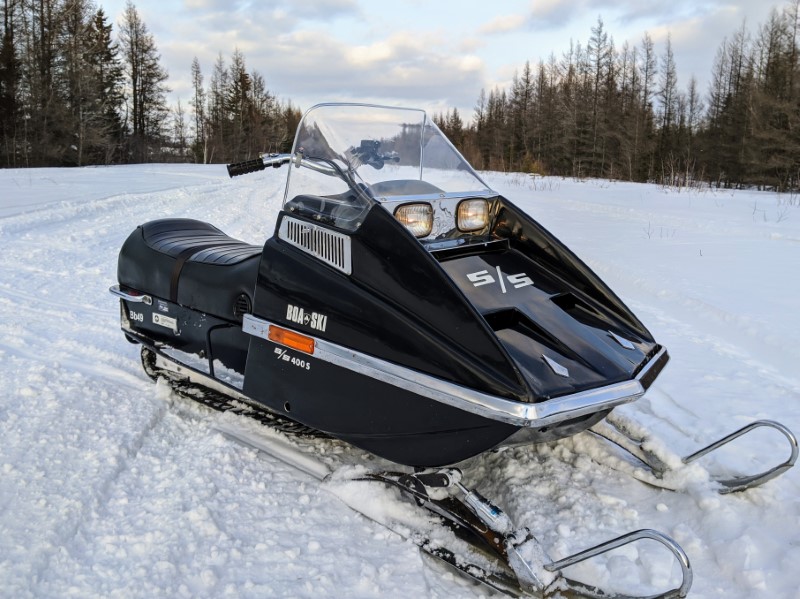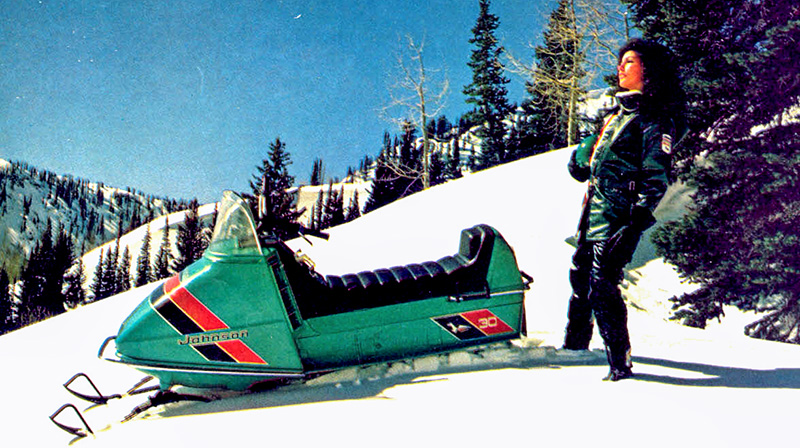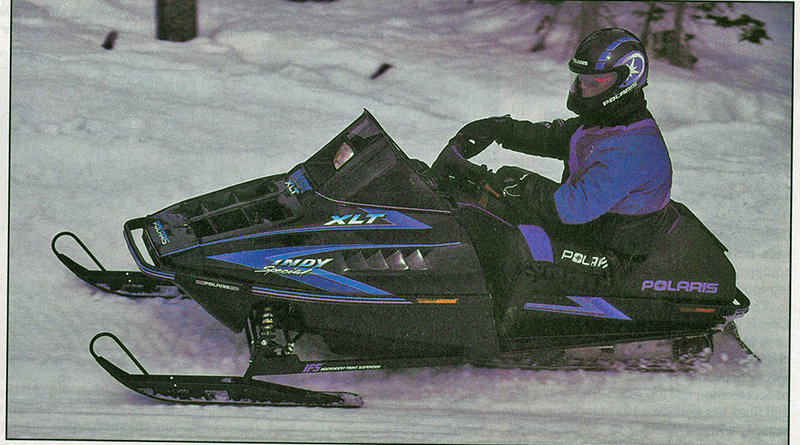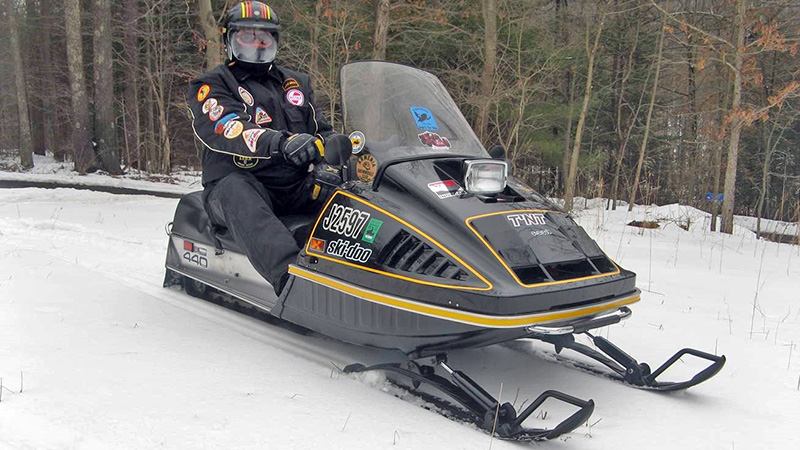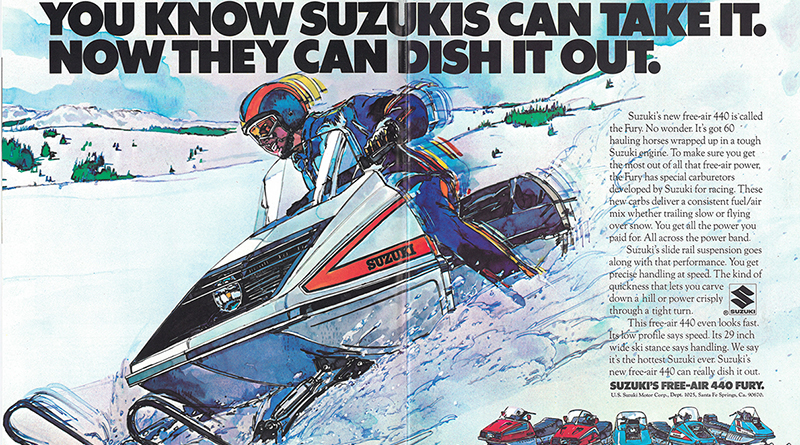
Suzuki Motor Corp. entered the snowmobile business in 1971, just prior to the industry’s all-time sales peak. Unfortunately, the reliable but homely Suzuki sleds failed to generate much interest. Hiring hockey star Bobby Hull as a spokesman didn’t help much, either. Only the high recognition of the Suzuki name kept them from getting lost in the “snowmachine mania” of the early 1970s.
The performance-minded company tried to go the racing-promotion route with unsuccessful attempts in cross-country and oval racing, culminating with four SnoPro sleds for the initial season of the factory racing circuit during the winter of 1973-74. Sadly, the Suzuki SnoPros were not competitive and became just another obscure footnote in snowmobile history. The company even tried to entice snowmobilers into another kind of racing, called Snocross, but that didn’t get off the ground, either.
So the motorcycle giant changed strategy. It would have a hot sled built for it by someone else, but one that used Suzuki’s own powerful engine technology. Contract manufacturing was common in the burgeoning snowmobile industry, with numerous examples ranging from Polaris building badge-engineered Homelite and Sears sleds all the way to Skiroule manufacturing significantly different machines for Ariens.
The choice of a vendor was easy. Suzuki was already engaged in long-term engine testing with Arctic Enterprises Inc., which had a new, modern assembly facility in northwestern Minnesota. With demand for anything gas-powered falling sharply following the 1973 oil embargo, Arctic Cat was actively looking for this kind of contract manufacturing business.
Thus the Suzuki Fury was born, with Arctic Enterprises getting a three-year contract to manufacture the new model.
A Cat By A Different Name
The 1975 Suzuki Fury was essentially a 1974 Arctic Cat El Tigre with a Suzuki engine instead of a Kawasaki powerplant under a new and unique hood.
The Suzuki 432cc free-air twin was quite similar to the Kawasaki two-cylinder performance engines that Cat had used since 1971, so it dropped right into the El Tigre chassis with minimal issues. Even the twin pipes on this new Suzuki engine caused no problems because this chassis had been originally developed for the 1972 EXT with twin-pipe Kawasaki racing engines. It was a slam-dunk, so to speak.
There was a difference in power output, however. A ram-air box, velocity stacks on the carbs, new CEM manufacturing technology for harder cylinder walls that allowed closer tolerances, and the twin exhaust pipes helped the Suzuki engine develop 60 hp and 40.8 pound-feet of torque at 7500 rpm – five horses more than the single-piped Kawasaki-powered El Tigres or probably any other air-cooled sled available in 1975.
Other changes included a jointly developed slide rail suspension carrying a 15-inch wide cleated track, an improved seat with a slightly concave butt pocket and integral tool box, a larger gas tank and a Suzuki snow flap. But the tunnel, rear bumper, tail light, instrument console, front suspension, fiberglass belly pan and numerous other items were carried over from the ’74 Cats. Surprisingly for a performance sled, a tow hitch was standard equipment.
The headlight was hidden behind the horizontally slotted grille in the same style as on the 1975 El Tigre models. Like its Cat half-brother, the Fury was well-equipped for its day with a disc brake, parking brake, speedometer with odometer, tachometer, padded handlebars, comfortable but rugged plastic throttle and brake levers, an effective windshield, rubber bumpers in the ski suspension and chrome-plated ski shocks.
A bare, aluminum tunnel complimented the new silver metal-flake hood and silver belly pan. Bright orange and black trim completed the significant departure from the blue, white and red color schemes on other Suzuki snowmobiles.
About 3,500 Fury snowmobiles were built and sold alongside the 1975 versions of the existing Suzuki family machines. But the Fury received minimal promotional support and wasn’t listed in many of Suzuki’s snowmobile flyers.
As an all-new model, the Fury did get some publicity in snowmobile publications, but not to the extent many other models from higher-profile brands were covered.
With no Suzuki racing network to exploit the Fury’s considerable performance capabilities, there is no record of any competitive use.
In short, Suzuki hardly promoted this fast and capable new machine and just let its dealers move them as best they could.
Corporate Upheaval

Despite the industry’s considerable contraction in the wake of the oil embargo, Kawasaki forged ahead with plans to become a full-fledged manufacturer of its own sleds. It began searching for an existing brand to purchase as a shortcut to establishing a viable dealer network. Arctic Cat was less than thrilled with the quality and reliability of the early Kawasaki snowmobile engines, and was actively examining other alternatives.
In March of 1975, Snow Week carried Arctic President John Penn’s official announcement of a new engine series for Arctic Cat snowmobiles beginning with the 1976 model year. Called the “Spirit” engine, the new powerplant would be built in multiple versions by Suzuki – at the time the world’s largest manufacturer of two-stroke engines with displacements more than 50cc.
Cat chose Suzuki over two other potential engine suppliers following three years of testing. After it became evident that Kawasaki was going to market its own brand of snowmobiles, the Cat-Suzuki business details were solidified during the summer of 1974 while Arctic Cat was building the Fury under contract.
Following Penn’s announcement, Suzuki quietly pulled the plug on its brand, joining half a dozen other companies that abandoned the snowmobile business after another difficult and generally unprofitable year. Nothing more was said about the remaining two years on Arctic’s manufacturing contract for the Fury.
Soon Suzuki-powered 1976 El Tigres, Jags and other models began flowing from Arctic Cat’s assembly lines. The new Jag was essentially a stripped-down ’74 El Tigre-with a 340cc free air engine. In other words, another variation on the Suzuki engine in the ’72 EXT chassis theme, just like the Fury.
The public announcement of Kawasaki’s acquisition of Sno*Jet from Conroy Corp. was made on December 1, 1975. Arctic Enterprises was retained by Kawasaki to assemble its low-end 1976 models, which were simply re-labeled Sno*Jets with Cat hex drive primary clutches and other minor changes. Arctic would go on to do limited contract manufacturing for other brands including Rupp, and the Cat-built 1981 Scorpion Sidewinder would also use a Suzuki engine.
The Fury – a one-year wonder that hardly anyone knew about – was the last and best of the Suzuki snowmobiles. More than that, this little-known and generally forgotten model was Arctic Cat’s bridge from Kawasaki to Suzuki engines.
Editor’s Note: This Flashback article from International Snowmobile Hall of Fame writer David Wells first appeared in Snow Goer magazine. To see more of Wells’ great articles on interesting old sleds, plus in-depth new sled evaluations, aftermarket product tests, informative how-to story, interesting travel features, Snowmobile Science articles and much more, subscribe to Snow Goer magazine.

